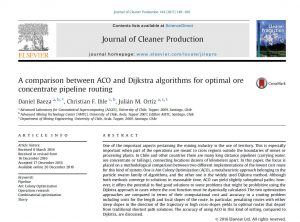 This paper was recently published in the Journal of Cleaner Production.
This paper was recently published in the Journal of Cleaner Production.
You can find it here.
[su_divider]
A comparison between ACO and Dijkstra algorithms for optimal ore concentrate pipeline routing
Daniel Baeza (Advanced Laboratory for Geostatistical Supercomputing (ALGES), University of Chile, Tupper, 2069, Santiago, Chile; Advanced Mining Technology Center (AMTC), University of Chile, Avda. Tupper 2007, Edificio AMTC, Santiago, Chile), Christian F. Ihle (Department of Mining Engineering, University of Chile, Avda. Tupper, 2069, Santiago, Chile; Advanced Mining Technology Center (AMTC), University of Chile, Avda. Tupper 2007, Edificio AMTC, Santiago, Chile), Julian M. Ortiz (Advanced Laboratory for Geostatistical Supercomputing (ALGES), University of Chile, Tupper, 2069, Santiago, Chile; Department of Mining Engineering, University of Chile, Avda. Tupper, 2069, Santiago, Chile)
Abstract
One of the important aspects pertaining the mining industry is the use of territory. This is especially important when part of the operations are meant to cross regions outside the boundaries of mines or processing plants. In Chile and other countries there are many long distance pipelines (carrying water, ore concentrate or tailings), connecting locations dozens of kilometers apart. In this paper, the focus is placed on a methodological comparison between two different implementations of the lowest cost route for this kind of system. One is Ant Colony Optimization (ACO), a metaheuristic approach belonging to the
particle swarm family of algorithms, and the other one is the widely used Dijkstra method. Although both methods converge to solutions in reasonable time, ACO can yield slightly suboptimal paths; however, it offers the potential to find good solutions to some problems that might be prohibitive using the
Dijkstra approach in cases where the cost function must be dyamically calculated. The two optimization approaches are compared in terms of their computational cost and accuracy in a routing problem including costs for the length and local slopes of the route. In particular, penalizing routes with either
steep slopes in the direction of the trajectory or high cross-slopes yields to optimal routes that depart from traditional shortest path solutions. The accuracy of using ACO in this kind of setting, compared to Dijkstra, are discussed.
